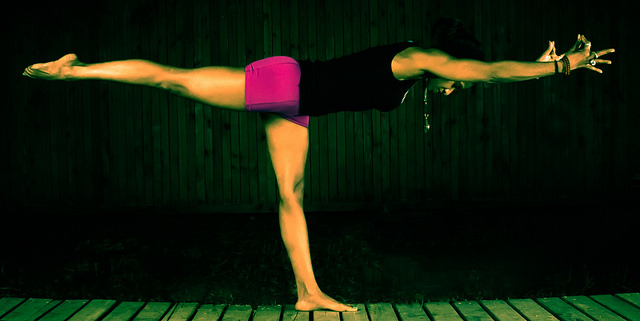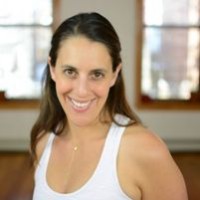I fell madly in love when I first met yoga. The bliss, the euphoria, and the adrenalin grabbed me by the lapels and didn’t let go for years.
I had finally found a home for my naturally flexible body. It was a place I could excel and be rewarded for the extra-pretzel-y things I could do with my body and I loved doing them. Never really a super sporty type, my zone of play had always been in movement but I had never before experienced the connection I felt to my body like I did in yoga.
Like any relationship that starts fast and furious, I dove in head first, getting my certifications, practicing in India and opening my own studio all within a very short time. This was it, or so I thought. I had met my movement match and we were headed for a lifetime of limber love together.
Until, like most fast and furious marriages, the honeymoon was over and I started noticing little aches and pains, small weaknesses popping up and my allegiance waning.
I chose to ignore what my body was telling me and just did more yoga, pushed my flexibility repeatedly and got myself saddled with my first big heartbreak—a disc injury in the spine.
Actually it was three disks and they were completely herniated. In the ER, doctors told me I would never move the same again and an operation done immediately was my best option for “recovery.” Not having the operation, I was told, would put my nerves at risk for permanent damage.
Having seen my dad go through multiple unsuccessful bag surgeries, I decided to risk it and opt out of surgery.
Here I was an avid yogi, bedridden for three months, on pain killers and anti-inflammatory meds, facing the possibility of never walking right again—all at only 25 years old. Yoga asana had put a really bad taste in my mouth and after wallowing in self-pity for a long minute, I became determined to get to the “core” of my problem (pun intended).
A friend sent me the book “Back Care Basics” and as I read it cover to cover, it dawned on me that my own movement choices had really created this situation and, unless I addressed that, I would never get relief.
So I began seeking out the scientific validation for my own experience of yoga asana as damaging to my body. I began to study anatomy, biomechanics and movement therapy intensely. And what I discovered shocked me—all the encouragement of flexibility in yoga was was actually quite damaging. The contortion poses created excessive joint ranges, the deep lunges were often just a lot of hanging out in connective tissue and the multitude of hip opening came at the expense of strong ligaments designed to hold the hips together rather than pulled apart constantly like taffy.
Yes, sadly a lot of how yoga asana is taught can be injurious to the body.
Yoga poses aren’t totally to blame—how they are taught is. Asana, or poses, is just one tiny part of yoga. But it is what everyone is practicing and not everyone understands how to practice with integrity.
Most people have no idea how to modify yoga poses to serve them and, sadly, many teachers aren’t equipped to guide those students into a healthy way of practicing. Not one teacher I had until that moment had talked to me of stability and strength, habits and patterns. It was always about getting deeper and deeper into poses. Achieving harder, more complicated balancing, leg-behind-head-contortionist poses. Not at all very yogic in nature. In fact, very ego driven.
Once I recognized in myself all the ways that I was cheating in yoga and just really destabilizing and damaging my body, I could see it in others. And I could not teach those poses and go to bed at night feeling good about myself.
More and more colleagues were getting injured and high-level, well-known yoga teacher friends of mine were hobbling around with torn ligaments trying to brush it under the rug and hoping they would heal fast without anyone finding out. Or, even worse, actually buying into the whole pain is part of the process BS that is thrown around the yoga world.
One of my friends who works in a well-known acupuncture office had even reported to me that his practice had become a revolving door for senior yoga teachers with joint related injuries. This was starting to look like an epidemic!
So what did I do with all of this new information I had? I began to modify my teachings to be less about flexibility and much more about stability and strength. And I took out all of the cover photo-worthy poses—contortion poses that are widely shared on social media but have very little merit physically.
As I did that, my own body stopped hurting.
I had three super pregnancies without the aches and pains and I felt strong and grounded in my body. I was no longer aspiring to that classic yogi desire. I was now fascinated by using my body well and being truly connected to it. Understanding what it needed and thrived on was way more rewarding than getting my leg behind my head. Yoga and I had a new song—a remix if you will.
As I pared down on the poses I felt comfortable teaching—and threw in other non yoga exercises in my classes—my classes looked less and less like a regular yoga class but had the same quality of attention, presence and serenity as a regular yoga class.
My own self practice became a jumble of yoga, strength, core work, restorative work and stability “drills.” It felt like yoga to me and my body thrived. And even though I call it yoga, it is a far cry from how I was taught and trained in yoga.
And guess what? I found that those people looking to move fast and do fancy poses were no longer in my classes, replaced by a different yogi—an introspective one, a curious and mindful one. One that was wise and looking to feel harmonious with their bodies.
And the best was that my people stopped getting injured and started feeling amazing and whole. And that brought me joy and fulfillment that came from having gone through the pain and disappointment.
My pain was my greatest teacher and it catapulted me into my life’s work, but my goal is to make sure people can avoid the pain to get to the gold.
I want to share with you my top four quick and easy tips to getting the most out of yoga, without injury:
Find a teacher who can teach you what your habits and blind spots are.
Once you learn what your default movement cheats are, you can learn to move better and get balanced. Every yoga class you go to will be an opportunity to undo your old habits and create better, more helpful ones.
The uber obvious one: listen, listen, listen to your body.
I guarantee you, your body is talking to you. Who cares that your mat neighbor is a contortionist? I promise you they aren’t happier people—just tune them out. Don’t be competitive and listen to your boundaries.
Find the teachers who take you deeper.
Like, real deeper on your life journey—not yoga fancy pose deeper. A teacher whose goal is to get you into complicated contortionist poses is not who you want to spend your time with or money on. Find the teachers who are deep and will take you on a real journey.
The more you move throughout the day—and in a variety of shapes—the less yoga you need!
That’s right. If you change your position often, stand for work more, walk more, sit on the floor more, the less you need to stretch. The reason so many of us are so tight is because our movement repertoire is so limited and we sit for so many hours a day. Change your all day long habits and your body will change too.
Relephant:
Yoga Nasties: Lessons Learned as a New Teacher.
Author: Lauren Ohayon
Assistant Editor: Hilda Carroll/Editor: Catherine Monkman
Photo: AnnHarkness/Flickr








Read 24 comments and reply